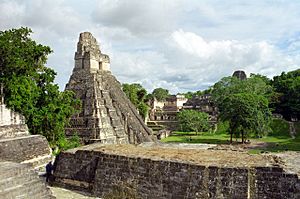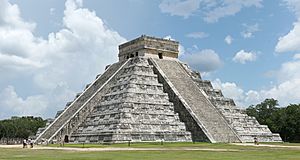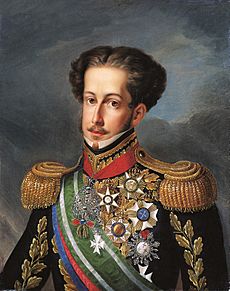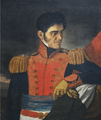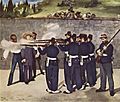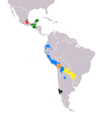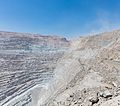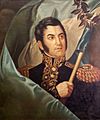Latin America facts for kids
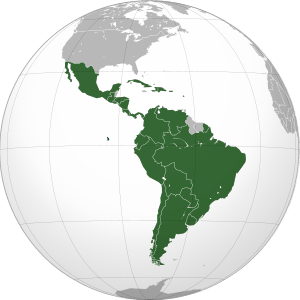 |
|
| Area | 20,111,457 km2 (7,765,077 sq mi) |
|---|---|
| Population | 642,216,682 (2018 est.) |
| Population density | 31/km2 (80/sq mi) |
| Ethnic groups |
|
| Demonym | Latin American |
| Countries | 20 |
| Dependencies | 14 |
| Languages | Romance languages Others: Quechua, Mayan languages, Haitian Creole, Antillean Creole, Guaraní, Caribbean Hindustani, Aymara, Nahuatl, English, German, Dutch, Mapudungun, Yiddish, Welsh, Russian, Ukrainian, Polish, Greek, Arabic, Chinese, Japanese, Korean, other languages |
| Time zones | UTC−02:00 to UTC−08:00 |
| Largest cities | Largest urban areas: 1. São Paulo 2. Mexico City 3. Buenos Aires 4. Rio de Janeiro 5. Bogotá 6. Lima 7. Santiago 8. Guadalajara 9. Monterrey 10. Belo Horizonte |
| UN M49 code | 419 – Latin America and the Caribbean019 – Americas001 – World |
Latin America is a region of the Americas. People do not completely agree which countries are in Latin America, but normally, it is the parts where Spanish and Portuguese are spoken (South America, Central America, and Mexico). Sometimes the Caribbean Islands are also included. Other people call all American countries where people speak Spanish, Portuguese, and French Latin America.
The words Latin America come from the use of languages that came from Latin. The Spanish, Portuguese, and French languages, spoken by many people in Latin America, are Romance languages. Romance languages are derived from Latin. Not all people in Latin America speak Romance languages, some Latin American people speak English like Guyana, Trinidad and Tobago or Belize. Suriname speaks Dutch and many countries have a large population that speaks Native American languages. Paraguay is the only country that has a native language as its official language, which is the Guarany language.
Most Latin Americans are Roman Catholic.
Contents
- Subregions and countries
- History
- Demographics
- Economy
- Tourism
- Poverty and inequality
- Related pages
- Images for kids
- See also
Subregions and countries
Latin America can be subdivided into several subregions based on geography, politics, democracy, demographics and culture. The basic geographical subregions are North America, Central America, the Caribbean and South America; the latter contains further politico-geographical subdivisions such as the Southern Cone, the Guianas and the Andean states. It may be subdivided on linguistic grounds into Spanish America, Portuguese America, and French America.
The term "Latin America" is defined to mean parts of Americas south of USA mainland where a Romance language (a language derived from Latin) predominates, that is, a language of Spanish, Portuguese or French. As is customary, Puerto Rico is included and Dominica, Grenada, and Saint Lucia (where French is spoken but not official language) are excluded from Latin America.
*: Not a sovereign state
History
Pre-Columbian history
The earliest known settlement was identified at Monte Verde, near Puerto Montt in Southern Chile. Its occupation dates to some 14,000 years ago and there is some disputed evidence of even earlier occupation. Over the course of millennia, people spread to all parts of the continents. By the first millennium AD/CE, South America's vast rainforests, mountains, plains and coasts were the home of tens of millions of people. The earliest settlements in the Americas are of the Las Vegas Culture from about 8000 BC and 4600 BC, a sedentary group from the coast of Ecuador, the forefathers of the more known Valdivia culture, of the same era. Some groups formed more permanent settlements such as the Chibchas (or "Muiscas" or "Muyscas") and the Tairona groups. These groups are in the circum Caribbean region. The Chibchas of Colombia, the Quechuas and Aymaras of Bolivia and Perú were the three indigenous groups that settled most permanently.

The region was home to many indigenous peoples and advanced civilizations, including the Aztecs, Toltecs, Caribs, Tupi, Maya, and Inca. The golden age of the Maya began about 250, with the last two great civilizations, the Aztecs and Incas, emerging into prominence later on in the early fourteenth century and mid-fifteenth centuries, respectively. The Aztec empire was ultimately the most powerful civilization known throughout the Americas, until its downfall in part by the Spanish invasion.
European colonization
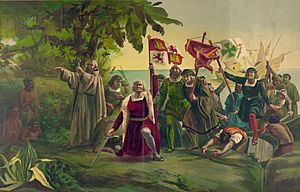
With the arrival of the Europeans following Christopher Columbus' voyages, the indigenous elites, such as the Incas and Aztecs, lost power to the heavy European invasion. Hernándo Cortés seized the Aztec elite's power with the help of local groups who did not favor the Aztec elite, and Francisco Pizarro eliminated the Incan rule in Western South America. The European powers of Spain and Portugal colonized the region, which along with the rest of the uncolonized world, was divided into areas of Spanish and Portuguese control by the line of demarcation in 1494, which gave Spain all areas to the west, and Portugal all areas to the east (the Portuguese lands in South America subsequently becoming Brazil).
By the end of the sixteenth century Spain and Portugal had been joined by others, including France, in occupying large areas of North, Central and South America, ultimately extending from Alaska to the southern tips of the Patagonia. European culture, customs and government were introduced, with the Roman Catholic Church becoming the major economic and political power to overrule the traditional ways of the region, eventually becoming the only official religion of the Americas during this period.
Epidemics of diseases brought by the Europeans, such as smallpox and measles, wiped out a large portion of the indigenous population. Historians cannot determine the number of natives who died due to European diseases, but some put the figures as high as 85% and as low as 25%. Due to the lack of written records, specific numbers are hard to verify. Many of the survivors were forced to work in European plantations and mines. Intermixing between the indigenous peoples and the European colonists was very common, and, by the end of the colonial period, people of mixed ancestry (mestizos) formed majorities in several colonies.
Independence (1804–1825)
In 1804, Haiti became the first Latin American nation to gain independence, following a violent slave revolt led by Toussaint L'ouverture on the French colony of Saint-Domingue. The victors abolished slavery. Haitian independence inspired independence movements in Spanish America.
By the end of the eighteenth century, Spanish and Portuguese power waned on the global scene as other European powers took their place, notably Britain and France. Resentment grew among the majority of the population in Latin America over the restrictions imposed by the Spanish government, as well as the dominance of native Spaniards (Iberian-born Peninsulares) in the major social and political institutions. Napoleon's invasion of Spain in 1808 marked a turning point, compelling Criollo elites to form juntas that advocated independence. Also, the newly independent Haiti, the second oldest nation in the New World after the United States, further fueled the independence movement by inspiring the leaders of the movement, such as Miguel Hidalgo y Costilla of México, Simón Bolívar of Venezuela and José de San Martín of Argentina, and by providing them with considerable munitions and troops.
Fighting soon broke out between juntas and the Spanish colonial authorities, with initial victories for the advocates of independence. Eventually these early movements were crushed by the royalist troops by 1810, including those of Miguel Hidalgo y Costilla in Mexico in the year 1810. Later on Francisco de Miranda in Venezuela by 1812. Under the leadership of a new generation of leaders, such as Simón Bolívar "The Liberator", José de San Martín of Argentina, and other Libertadores in South America, the independence movement regained strength, and by 1825, all Spanish America, except for Puerto Rico and Cuba, had gained independence from Spain. Brazil achieved independence with a constitutional monarchy established in 1822. In the same year in Mexico, a military officer, Agustín de Iturbide, led a coalition of conservatives and liberals who created a constitutional monarchy, with Iturbide as emperor. This First Mexican Empire was short-lived, and was followed by the creation of a republic in 1823.
Consolidation and liberal-conservative conflicts (1825–1900)
World wars (1914–1945)
Brazil's participation in World War II
After World War I, in which Brazil was an ally of the United States, Great Britain, and France, the country realized it needed a more capable army but didn't have the technology to create it. In 1919, the French Military Mission was established by the French Commission in Brazil. Their main goal was to contain the inner rebellions in Brazil. They tried to assist the army by bringing them up to the European military standard but constant civil missions did not prepare them for World War II.
Brazil President, Getúlio Vargas, wanted to industrialize Brazil allowing it to be more competitive with other countries. He reached out to Germany, Italy, France, and the United States to act as trade allies. Many Italian and German people immigrated to Brazil many years before World War II began thus creating a Nazi influence. The immigrants held high positions in government and the armed forces. It was not a secret that Vargas had an admiration for Hitler's Nazi Germany and its Führer. He even let German Luftwaffe build secret air forces around Brazil, but he knew that he could never favor the Nazis because of their racism towards the large black population in Brazil. This alliance with Germany became Brazil's second best trade alliance behind the United States.
Brazil continued to try to remain neutral to the United States and Germany because it was trying to make sure it could continue to be a place of interest for both opposing countries. Brazil attended continental meetings in Buenos Aires, Argentina (1936); Lima, Peru (1938); and Havana, Cuba (1940) that obligated them to agree to defend any part of the Americas if they were to be attacked. Eventually Brazil decided to stop trading with Germany once Germany started attacking offshore trading ships resulting in Germany declaring a blockade against the Americas in the Atlantic Ocean. Furthermore, Germany also ensured that they would be attacking the Americas soon.
Once the German submarines attacked unarmed Brazilian trading ships, President Vargas met with United States President Franklin D. Roosevelt to discuss how they could retaliate. On January 22, 1942, Brazil officially ended all relations with Germany, Japan, and Italy, becoming a part of the Allies.
The Brazilian Expeditionary Force was sent to Naples, Italy to fight for democracy. Brazil was the only Latin American country to send troops to Europe. Initially, Brazil wanted to only provide resources and shelter for the war to have a chance of gaining a high postwar status but ended up sending 25,000 men to fight.
After World War II, the United States and Latin America continued to have a close relationship.
Involvement in World War II
There was Nazi influence in certain parts of the country, but Jewish migration from Europe during the war continued. Only a small number of people recognized or knew about the Holocaust. Furthermore, numerous military bases were built during the war by the U.S, but some also by the Germans. Even now, unexploded bombs from the second world war that need to be made safe still remain.
Cold War (1946–1990)
Economy
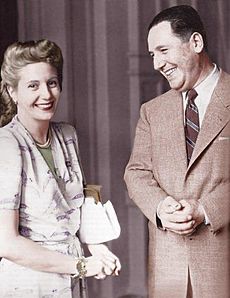
The Great Depression caused Latin America to grow at a slow rate, separating it from leading industrial democracies. The two world wars and U.S. Depression also made Latin American countries favor internal economic development, leading Latin America to adopt the policy of import substitution industrialization. Countries also renewed emphasis on exports. Brazil began selling automobiles to other countries, and some Latin American countries set up plants to assemble imported parts, letting other countries take advantage of Latin America's low labor costs. Colombia began to export flowers, emeralds and coffee grains and gold, becoming the world's second leading flower exporter.
Economic integration was called for, to attain economies that could compete with the economies of the U.S or Europe. Starting in the 1960s with the Latin American Free Trade Association and Central American Common Market, Latin American countries worked toward economic integration.
Reforms
Large countries like Argentina called for reforms to lessen the disparity of wealth between the rich and the poor, which has been a long problem in Latin America that stunted economic growth.
Advances in public health caused an explosion of population growth, making it difficult to provide social services. Education expanded, and social security systems introduced, but benefits usually went to the middle class, not the poor. As a result, disparity of wealth increased. Increasing inflation and other factors caused countries to be unwilling to fund social development programs to help the poor.
Bureaucratic authoritarianism
Bureaucratic authoritarianism was practiced in Brazil after 1964, in Argentina, and in Chile under Augusto Pinochet, in a response to harsh economic conditions. It rested on the conviction that no democracy could take the harsh measures to curb inflation, reassure investors, and quicken economic growth quickly and effectively. Though inflation fell sharply, industrial production dropped with the decline of official protection.
U.S. Relations
After World War II and the beginning of a Cold War between the U.S. and the Soviet Union, U.S. diplomats became interested in Asia, Africa, and Latin America, and frequently waged proxy wars against the Soviet Union in these countries. The U.S. sought to stop the spread of communism. Latin Americans generally resented the U.S. superiority over them. Latin America also complained of the U.S. support to locals in overthrowing nationalist governments, and intervention through the CIA. Still, Latin America respected the U.S. during this time, and Latin American countries generally sided with the U.S., even though they complained of being neglected by the U.S.'s concern with communism in Europe and Asia, not Latin America. In 1947, the U.S. Congress passed the National Security Act, which created the National Security Council in response to the United States's growing obsession with anti-communism.
In 1954, when Jacobo Arbenz of Guatemala accepted the support of communists and attacked holdings of the United Fruit Company, the U.S. decided to assist Guatemalan counterrevolutionaries in overthrowing Arbenz. These interventionist tactics featured use of the CIA rather than the military, which would be used in Latin America for the majority of the Cold War in events like the overthrow of Salvador Allende. Latin America was more concerned with issues of economic development, while the United States focused on fighting communism, even though the presence of communism was small in Latin America.
Cuban Revolution

By 1959, Cuba was afflicted with a corrupt dictatorship under Batista, and Fidel Castro ousted Batista that year and set up the first communist state in the hemisphere. The U.S. imposed a trade embargo on Cuba, and combined with Castro's expropriation of private enterprises, this was detrimental to the Cuban economy. Around Latin America, rural guerrilla conflict and urban terrorism increased, inspired by the Cuban example. The United States put down these rebellions by supporting Latin American countries in their counter guerrilla operations through the Alliance for Progress launched by President John F. Kennedy. This thrust appeared to be successful. A Marxist, Salvador Allende, became president of Chile in 1970, but was overthrown three years later in a military coup. Despite civil war, high crime and political instability, most Latin American countries eventually adopted democracies besides Cuba.
Bay of Pigs Invasion
Encouraged by the Guatemala success, Kennedy, in 1960, decided to launch an attack on Cuba. The Bay of Pigs invasion was an abortive invasion of Cuba in 1961, financed by the U.S. through the CIA, to overthrow Castro. The incident proved to be very embarrassing for the new Kennedy administration.
Alliance for Progress
President John F. Kennedy initiated the Alliance for Progress in 1961, to establish economic cooperation between the U.S. and Latin America. The Alliance would provide $20 billion for reform in Latin America, and counterinsurgency measures. Instead, the reform failed because of the simplistic theory that guided it and the lack of experienced American experts who could understand Latin American customs.
Cuban missile crisis
The Cuban Missile crisis nearly brought the U.S. and the Soviet Union to war in October 1962. Soviet premier Nikita Khrushchev had installed several missiles in Cuba that could hit most of the Eastern United States. President Kennedy decided to place a naval blockade on Cuba to prevent further Soviet shipments of missiles. In the end, Khrushchev submitted, taking missiles away. In return, Kennedy agreed never to invade Cuba, and to withdraw nuclear-arms from Turkey.
Washington Consensus
The set of specific economic policy prescriptions that were considered the "standard" reform package were promoted for crisis-wracked developing countries by Washington, D.C.-based institutions such as the International Monetary Fund (IMF), World Bank, and the US Treasury Department during the 1980s and 1990s.
In recent years, several Latin American countries led by socialist or other left wing governments – including Argentina and Venezuela – have campaigned for (and to some degree adopted) policies contrary to the Washington Consensus set of policies. (Other Latin countries with governments of the left, including Brazil, Chile and Peru, have in practice adopted the bulk of the policies.) Also critical of the policies as actually promoted by the International Monetary Fund have been some U.S. economists, such as Joseph Stiglitz and Dani Rodrik, who have challenged what are sometimes described as the "fundamentalist" policies of the International Monetary Fund and the US Treasury for what Stiglitz calls a "one size fits all" treatment of individual economies.
The term has become associated with neoliberal policies in general and drawn into the broader debate over the expanding role of the free market, constraints upon the state, and US influence on other countries' national sovereignty.
This politico-economical initiative was institutionalized in North America by the 1994 NAFTA, and elsewhere in the Americas through a series of like agreements. The comprehensive Free Trade Area of the Americas project, however, was rejected by most South American countries at the 2005 4th Summit of the Americas.
Demographics
Ethnic groups

The population of Latin America comprises various ethnic groups and races, making this continent the most diverse in the world today. The majority of Latin Americans are Mestizo (European-Native American); while some are dominated by Native Americans, others are dominated by people from Europe; and some others are Mulatto, Black, Zambo, and Asian. European/Whites are the largest single ethnic group, they and people of part-European makeup about as much as 80% of the Latin American population, possibly even more.
- Native American. The Native population in Latin America, came during the Lithic stage. They number in more than sixty million (by some experts). They makeup the majority only in Bolivia, Peru, and Guatemala. In Ecuador the Indeginous population is a large minority of about 1/4 of the population. Mexico's pure to almost pure Native American population is nearly 30% (with 9.8% to 15% being of pure blood), and is also one of the largest Amerindian population in the Americas in terms of absolute numbers. Most of the remaining countries have Native American minorities.
- European. In the 1500s, large numbers of Iberian colonists came to what is now Latin America. Today, most White Latin Americans are of Spanish and Portuguese origin. The Iberians brought their language, religion, and culture to Latin America. Brazil, Argentina, Mexico, and Colombia contains the largest numbers of Whites in Latin America. Whites makeup the majorities of Uruguay, Argentina, Costa Rica, Puerto Rico, and Chile. In Brazil, whites makeup over half of the population, 53.8%. Therefore with over 100 million people descendants of european whites, Brazil accounts for nearly two thirds of all the whites in the Latin America. The rest of the remaining countries have a White minority (small or large).
- African. Millions of African slaves were brought to the Americas from the early 1500s onward. The majority went to the Caribbean and Brazil. Among the Hispanic nations and Brazil, Dominican Republic is the only country in Latin America with a Black majority of about 80-90%. Significant populations include Cuba (35%), Puerto Rico (23%), Colombia (19%), and Venezuela (12%). The remaining countries have a Black minority (small or large), Panama has the largest Black population of Central America with about 14% of Panamanians being Black.
- Asian. People of Asian descent number several millions in Latin America. The majority of Asian Latin Americans are of Japanese and Chinese heritage, and they mostly live in Peru and Brazil. The largest community of Japanese ethnicity living outside of Japan, resides in Brazil. There is also a growing Chinese population in Panama, as well as Costa Rica (though, Chinese Costa Ricans are a large minority). In the Dominican Republic, there is a place where large numbers of Japanese people came; most Japanese Dominicans live in towns such as Bonao and Santo Domingo (though in the Capital's mostly comprised with Chinese people). Asian Latin Americans are also found anywhere in the Caribbean and other Latin American countries.
- Arab or Middle Eastern. Arabs in Latin America are also many, but they are mostly found among the Hispanic-Caribbean regions. In Cuba and Puerto Rico, the Arab population are actually in-blood lines of the Canarians and Southern Spaniards that colonized them. In the Dominican Republic, the Arabs arrived sometime between the 19th and 20th century; they makeup about 5% of Dominicans (most are Morracians, Lebanese and East Indians). Arabs are also many in Peru and Venezuela.
Largest cities
| Historical populations | ||
|---|---|---|
| Year | Pop. | ±% p.a. |
| 1750 | 16,000,000 | — |
| 1800 | 24,000,000 | +0.81% |
| 1850 | 38,000,000 | +0.92% |
| 1900 | 74,000,000 | +1.34% |
| 1950 | 167,000,000 | +1.64% |
| 2001 | 511,000,000 | +2.22% |
| 2013 | 603,191,486 | +1.39% |
| Source: "UN report 2004 data" (PDF) | ||
Urbanization accelerated starting in the mid-twentieth century, especially in capital cities, or in the case of Brazil, traditional economic and political hubs founded in the colonial era. In Mexico, the rapid growth and modernization in country's north has seen the growth of Monterrey, in Nuevo León. The following is a list of the ten largest metropolitan areas in Latin America. Entries in "bold" indicate they are ranked the highest.
| City | Country | 2017 population | 2014 GDP (PPP, $million, USD) | 2014 GDP per capita, (USD) |
|---|---|---|---|---|
| Mexico City | 23,655,355 | $403,561 | $19,239 | |
| São Paulo | 23,467,354 | $430,510 | $20,650 | |
| Buenos Aires | 15,564,354 | $315,885 | $23,606 | |
| Rio de Janeiro | 14,440,345 | $176,630 | $14,176 | |
| Lima | 9,804,609 | $176,447 | $16,530 | |
| Bogotá | 7,337,449 | $209,150 | $19,497 | |
| Santiago | 7,164,400 | $171,436 | $23,290 | |
| Belo Horizonte | 6,145,800 | $95,686 | $17,635 | |
| Guadalajara | 4,687,700 | $80,656 | $17,206 | |
| Monterrey | 4,344,200 | $122,896 | $28,290 |
Language
Spanish and Portuguese are the dominant languages of Latin America. Portuguese dominates Brazil. Spanish is the official language of most other Latin America mainland countries, and of Cuba, Puerto Rico (along with English), and the Dominican Republic.
Native American languages are widely spoken in Peru, Guatemala, Bolivia, Paraguay and Mexico. They are less used in other countries.
Other European languages spoken in Latin America include English (mainly in Puerto Rico}, and French.
African languages are also spoken by few in Latin America. The west African Yoruba language (known as Lucumi) is spoken among the people of predominant Yoruba ancestry; it is spoken in Cuba where it is a ritual language used by the Santeria prayers.
In several nations, Creole languages are also spoken, especially in the Caribbean. Palenquero is the Spanish-based Creole language spoken in Colombia by some 3,000 people, it is Spanish with many African influences and some Portuguese influence. Other creoles in mainland Latin America have the same roots, blending Spanish with either African or Indigenous languages or both, as Cuban Spanish does.
Economy
According to some analysis, by 2050 the biggest economies in the world will be China (1), United States (2), India (3), Brazil (4), and Mexico (5).
Tourism
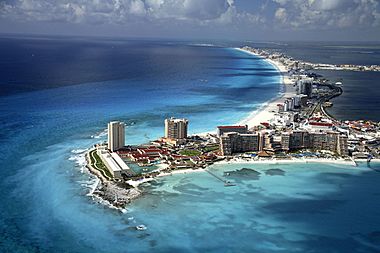
Income from tourism is key to the economy of several Latin American countries. Mexico is the only Latin American country to be ranked in the top 10 worldwide in the number of tourist visits. It received by far the largest number of international tourists, with 35.1 million visitors in 2016, followed by Brazil, with 6.6 million; the Dominican Republic, with 6 million; Chile, with 5.6 million; Argentina, with 5.5 million; Cuba with 4 million; Puerto Rico with 3.7 million; Peru with 3.7 million; and Colombia, with 3.3 million. The World Tourism Organization reports the following destinations as the top six tourism earners for the year 2016: Mexico, with US$19,571 million; the Dominican Republic, with US$6,723 million; Brazil, with US$6,024 million; Colombia, with US$4,773 million; Argentina, with US$4,687 million; and Panama, with US$4,258 million.
Places such as Cancún, Riviera Maya, Galápagos Islands, Punta Cana, Chichen Itza, Cartagena de Indias, Cabo San Lucas, Mexico City, Machu Picchu, Margarita Island, Acapulco, San Ignacio Miní, Santo Domingo, Buenos Aires, Salar de Uyuni, Rio de Janeiro, Punta del Este, Labadee, San Juan, São Paulo, La Habana, Panama City, Iguazú Falls, Puerto Vallarta, Poás Volcano National Park, Viña del Mar, Guanajuato City, Bogotá, Santa Marta, San Andrés, San Miguel de Allende, Lima, Guadalajara, Cuzco, Ponce and Perito Moreno Glacier are popular among international visitors in the region.
Poverty and inequality
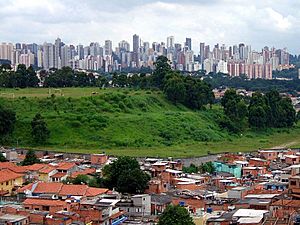
Poverty continues to be one of the biggest challenges for Latin American countries. According to estimates, Latin America is the most unequal regions of the world.
According to a Country Studies Institute the poorest countries in the region (in 2011) were: Haiti, Dominican Republic, Nicaragua, Bolivia and Honduras. Undernourishment affects 72% of Haitians, 47% of Nicaraguans and Bolivians, 32% of Hondurans and 27% of Dominicans.
Populations of below the poverty line; according to a Country Studies Institute, poverty affects over 90% of Haitians, 75% of Bolivians, 70% of Nicaraguans, 63% of Hondurans and 54% of Dominicans.
Related pages
Images for kids
-
Presencia de América Latina (Presence of Latin America, 1964–65) is a 300 m2 (3,230 sq ft) mural at the hall of the Arts House of the University of Concepción, Chile. It is also known as Latin America's Integration.
-
Surviving section of the Inca road system in Northwestern Argentina, now a UNESCO World Heritage Site. The road system linked the Andean empire
-
Monument to Christopher Columbus, Buenos Aires before its 2013 removal and replaced by the statue of Juana Azurduy, a mestiza fighter for independence.
-
Dom Pedro I, emperor of Brazil
-
Argentine caudillo Juan Manuel de Rosas
-
Mexican strongman Antonio López de Santa Anna
-
American occupation of Mexico City
-
The Execution of Emperor Maximilian, Édouard Manet 1868. The execution ended monarchic rule in Mexico, and Mexican liberals triumphed
-
The Zimmermann Telegram as it was sent from Washington to Ambassador Heinrich von Eckardt (German ambassador to Mexico)
-
Fidel Castro and his men in the Sierra Maestra, 2 December 1956
-
Cuba-U.S.S.R. friendship poster, with Castro and Nikita Khrushchev
-
Che Guevara Cuban revolutionary poster
-
Chilean dictator Augusto Pinochet and U.S. Secretary of State Henry Kissinger
-
Pope Paul VI and Salvadoran cleric Oscar Romero (now St Oscar Romero)
-
Comandanta Ramona of the Zapatista Army of National Liberation, Mexico
-
UNASUR summit in the Palacio de la Moneda, Santiago de Chile
-
Sugarcane plantation in São Paulo. In 2018, Brazil was the world's largest producer, with 746 million tons. Latin America produces more than half of the world's sugarcane.
-
Soybean plantation in Mato Grosso. In 2020, Brazil was the world's largest producer, with 130 million tons. Latin America produces half of the world's soybeans.
-
Coffee in Minas Gerais. In 2018, Brazil was the world's largest producer, with 3.5 million tons. Latin America produces half of the world's coffee.
-
Cerro Rico, Potosi, Bolivia, still a major silver mine
-
Amethyst mine in Ametista do Sul. Latin America is a major producer of gems such as amethyst, topaz, emeralds, aquamarine and tourmaline
-
Iron mine in Minas Gerais. Brazil is the world's second largest iron ore exporter.
-
Panama Canal expansion project; New Agua Clara locks (Atlantic side)
-
Itaipu Dam in Paraná.
-
Wind power in Parnaíba.
-
Angra Nuclear Power Plant in Angra dos Reis, Rio de Janeiro
-
Native New World crops exchanged globally: maize, tomato, potato, vanilla, rubber, cocoa, tobacco
-
Rafael Correa, Evo Morales, Néstor Kirchner, Cristina Fernández, Luiz Inácio Lula da Silva, Nicanor Duarte, and Hugo Chávez at the signing of the founding charter of the Bank of the South
-
Aerial view of Cancún. Mexico is the most visited country in Latin America and 6th in the world.
-
Roman Catholic Easter procession in Comayagua, Honduras
-
Diego Rivera's mural depicting Mexico's history at the National Palace in Mexico City
-
Mural by Santiago Martinez Delgado at the Colombian Congress
-
In 2015, Alejandro González Iñárritu became the second Mexican director in a row to win both the Academy Award for Best Director and the Directors Guild of America Award for Best Director. He won his second Oscar in 2016 for The Revenant.
-
President Cristina Fernández with the film director Juan José Campanella and the cast of The Secret in Their Eyes (2009) with the Oscar for Best Foreign Language Film
-
Sor Juana Inés de la Cruz in 1772 by Andrés de Islas
-
Argentine Jorge Luis Borges in L'Hôtel, Paris in 1969
-
Chilean poet Gabriela Mistral, first Latin American to win a Nobel Prize in Literature, in 1945
-
García Márquez signing a copy of One Hundred Years of Solitude
-
Brazilian singer Carmen Miranda helped popularize samba internationally.
-
A couple dances tango.
-
Sumidero Canyon, located in Chiapas, Mexico.
-
Glaucous macaw (behind hyacinth macaw) and other macaws. Macaws are long-tailed, often colorful New World parrots.
-
José de San Martín, Liberator of Argentina, Chile and Peru.
-
Bernardo O'Higgins, hero of Chilean independence
-
Father Miguel Hidalgo, father of Mexican independence, with the banner of Our Lady of Guadalupe
-
Vicente Guerrero, insurgent hero of Mexican independence, who joined with Iturbide
See also
 In Spanish: América Latina para niños
In Spanish: América Latina para niños


